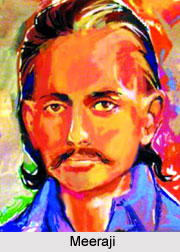 Meeraji was born on 25th May in the year 1912. He was an eminent Urdu poet, and lived the life of a bohemian.
Meeraji was born on 25th May in the year 1912. He was an eminent Urdu poet, and lived the life of a bohemian.
Early life of Meeraji
Meeraji was born into a Kashmiri family of Gujranwala and named Mohammed Sanaullah Dar and passed his childhood days in Kucha Sardar Shah, Mozang in Lahore. His father, Munshi Mohammad Mahtabuddin, was a railway engineer, so his family had to often move from one place to another. He lived in Kathiawar, Bostan (Baluchistan), Sanghar and Jacobabad.
Meeraji began composing poetry, under the pseudonym of Sasri, when he was at school. It was from his later encounter with a Bengali girl, Meera Sen, who was a daughter of an accounts officer serving in Lahore that he fell deeply in love. This left a permanent trace in his life that he adopted his pen name on her name. Meeraji, though brought up in affluent surroundings, Meeraji left his home and family and chose to lead the life of a homeless wanderer, mostly staying with his friends and making a living by selling his songs.
Literary life of Meeraji
Meeraji was associated with Adabi Duniya (Lahore), and later worked for All India Radio in Delhi. He wrote literary columns for the monthly Saqi in Delhi and for a short period helped editing Khayal (Mumbai). After Partition of India, he settled permanently in Mumbai.
From his teenage days, Meeraji felt attracted towards Hindu mythology. Hindi vocabulary often came across in his poetry, prose and letters. He also acknowledged his debt to the Sanskrit poet Amaru and the French poet Baudelaire. He also translated certain works of the Sanskrit poet, Damodar Gupta and of the Persian poet, Omar Khayyam.
Meeraji is considered to be one of the pioneers of symbolism in Urdu poetry, and especially introducing Free Verse. He also wrote illuminating criticism of poetry and yearned to alter the expression of his age.
Works of Meeraji
Meeraji`s literary output was immense but he is said to have published very little of his poetry during his lifetime. During Meeraji`s lifetime four collections of Meeraji`s works were published by Shahid Ahmed Dehlavi, and one by Maktaba-e-Urdu, Lahore. His complete works Kulliyat-e-Meeraji appeared only in 1988 edited by Dr. Jameel Jalibi. Another collection titled Baqiyat-e-Meeraji was edited by Sheema Majeed in 1990. A book titled "Iss Nazm Mein" containing Essays of Meeraji was published during his lifetime.
The list of the works of Meeraji:
"Meeraji ke Geet" (Poems)
"Meeraji ki Nazmen"(Poems)
"Teen Rang" (Poems)
"Iss Nazm Mein" (Criticism - Essays of Meeraji)
"Kulliyat-e-Meeraji" (Poems) compiled by Altaf Gauhar and published by Dr. Jameel Jalibi, Urdu Markaz U.K.
"Baqiyat-e-Meeraji" (Poems) edited by Sheema Majeed and published by Pakistan Books and Literary Sounds, Lahore.
"Intikhab-e-kalaam"
"Pratinidhi Shairy"
Personality of Meeraji
Meeraji had adopted a deliberately outlandish style in his dress. Supporting long, floating hair, a dagger-like moustache, over-size earrings, a colourful headgear, an amulet and a string of beads around his neck, he fits into Coleridge`s description of a poet - an inspired being with "flashing eyes and floating hair", who "on honey - dew hath fed/ And drunk the milk of Paradise ".u Mehr Lal Soni Zia Fatehabadi, his poet friend and former class fellow, recalled that the only time Meeraji trimmed his long hair, was when he joined All India Radio, New Delhi.
Meeraji died on 4rt November in the year 1949.



















